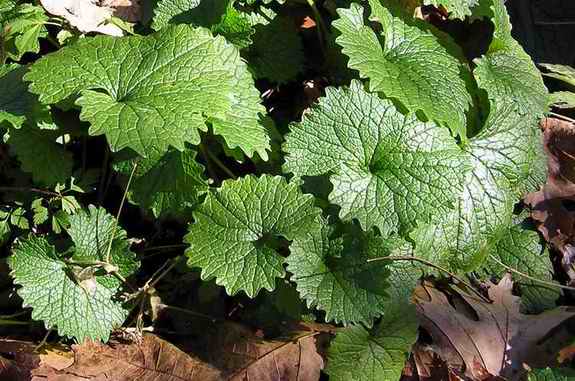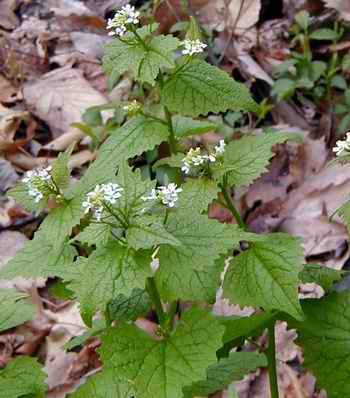|
Common Name: Garlic Mustard (for the garlic-onion smell of the plant that is a member of the mustard family), Hedge-Garlic, Sauce-Alone, Jack-by-the-Hedge, Poor Man's Mustard, Garlicwort, Mustard Root Scientific Name: Alliaria petiolata (Generic name from allium, Latin for garlic; petiolata from petioles, or leaf stalks, a characteristic of the plant) other forms are A. Alliaria, A. officinalis, Erysium Alliaria, Sisymbrium alliaria.
Garlic mustard is an invasive species. It was introduced from Europe to Long Island, New York in 1868, probably for use by early colonists as a foodstuff, as it had been in their native countries. It is widespread in Europe from England eastward to the Czech Republic and south to Italy, in North Africa and on the Indian subcontinent. Genetic variation analysis conducted in 2000 indicated that the North American variant probably arose from multiple sources, predominantly Great Britain and the Low Countries.
Garlic mustard aggressively monopolizes soil, space, and nutrients, driving out competing native species, notably spring beauty, bloodroot, hepatica, toothwort, and trillium. It is not a problem in its native habitats, as it is consumed by 69 species of insects, 5 of which feed exclusively, or are monophagous, on garlic mustard. None of these predators are native to North America. However, numerous field studies have demonstrated that its effects on native plant populations may not be as profound as widely claimed. One study found that areas with garlic mustard had the same species diversity as those without over a three year period. A second study found that jewelweed, a native plant, out competed garlic mustard.
Since garlic mustard reduces the number of other native plants, it also poses a threat to the insects that feed on those plants. In particular, the West Virginia white butterfly (Pieris virginiensis), which normally lays its eggs on toothworts (Dentaria), is stimulated to lay its eggs on garlic mustard as they both contain glucosinolate sinigrin, the triggering chemical. Unfortunately, most of the eggs laid on garlic mustard fail to hatch. In general, garlic mustard reduces the populations of native butterflies.
In addition to the absence of predators, garlic mustard is successful due to
its evolution of robust
Management of garlic mustard is a serious problem that requires a long term effort, as the seeds remain viable for up to five years. For light infestations, hand removal is feasible as long as the plants are extirpated. For larger areas, individual plants can be cut at ground level to eliminate seed dispersal, or treated with an herbicide, with appropriate care so as not to harm any nearby indigenous species. Systematic burning is a last resort. Whatever method is used, it must be repeated annually for up to five years to eliminate all seeds. Four monophagous garlic mustard eating weevils from Europe are being evaluated for possible use as biological controls in North America. However, the best management method is to prevent its initial infestation.
The many culinary names of garlic mustard are suggestive of its historic use as a potherb in its native countries. This was particularly true in the winter and the early spring, as there are few other greens available. The leaves of young plants can be eaten raw as a salad or can be cooked as a steamed vegetable, like spinach. It can also be used with other foods to impart a garlic flavor. It has been promoted for its high vitamin A content 8,600 units per 100 grams) and its high vitamin C content (190mg per 100 grams).
There have been a number of documented medicinal uses of garlic mustard. Ingesting the leaves has been used to induce sweating and to treat respiratory disorders such as bronchitis and asthma. Applied as a poultice externally, it has been found to be effective as a palliative for the itching caused by insect bites and stings. The seeds have been used as a snuff to induce sneezing. |

 survival traits. It spends the first year of its biennial (two year) life
cycle as a rosette of leaves. This is the form that is seen throughout the
winter, when they grow whenever there is no snow and the temperature is above
freezing. By the second spring they are well established and rapidly develop
into mature plants that flower and produce seeds. As garlic mustard flowers
are capable of self-fertilization, the pollination process is efficient, not
dependent on any external insect agents. Field studies have demonstrated that
a single plant produces an average of between 136 and 295 seeds, depending on
size of the plant and the habitat. Seed production in dense patches of garlic
mustard has been measured at between 3,607 and 45, 018 seeds per square
meter.
survival traits. It spends the first year of its biennial (two year) life
cycle as a rosette of leaves. This is the form that is seen throughout the
winter, when they grow whenever there is no snow and the temperature is above
freezing. By the second spring they are well established and rapidly develop
into mature plants that flower and produce seeds. As garlic mustard flowers
are capable of self-fertilization, the pollination process is efficient, not
dependent on any external insect agents. Field studies have demonstrated that
a single plant produces an average of between 136 and 295 seeds, depending on
size of the plant and the habitat. Seed production in dense patches of garlic
mustard has been measured at between 3,607 and 45, 018 seeds per square
meter.